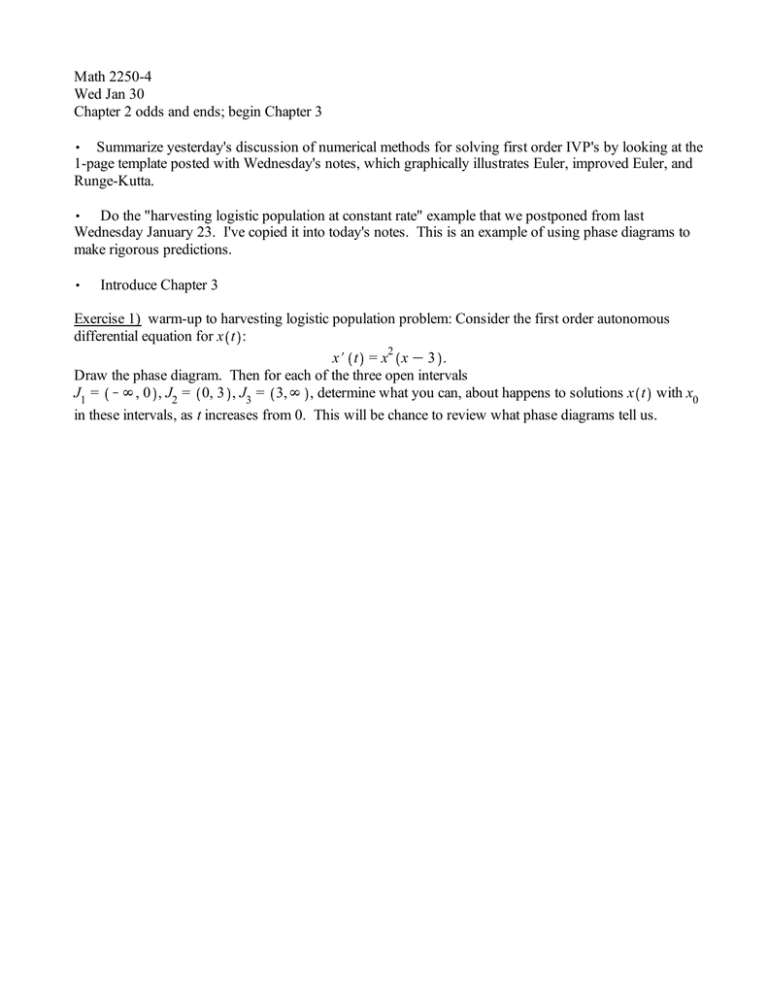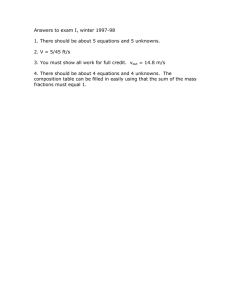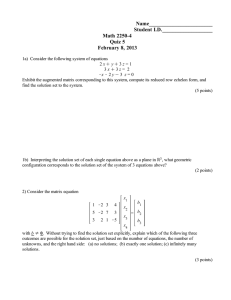Math 2250-4 Wed Jan 30
advertisement

Math 2250-4 Wed Jan 30 Chapter 2 odds and ends; begin Chapter 3 , Summarize yesterday's discussion of numerical methods for solving first order IVP's by looking at the 1-page template posted with Wednesday's notes, which graphically illustrates Euler, improved Euler, and Runge-Kutta. , Do the "harvesting logistic population at constant rate" example that we postponed from last Wednesday January 23. I've copied it into today's notes. This is an example of using phase diagrams to make rigorous predictions. , Introduce Chapter 3 Exercise 1) warm-up to harvesting logistic population problem: Consider the first order autonomous differential equation for x t : x# t = x2 x K 3 . Draw the phase diagram. Then for each of the three open intervals J1 = KN, 0 , J2 = 0, 3 , J3 = 3,N , determine what you can, about happens to solutions x t with x0 in these intervals, as t increases from 0. This will be chance to review what phase diagrams tell us. , Discuss the logistic equation with constant rate harvesting model, from Wednesday January 23 and also the text p. 97: (or, why do fisheries sometimes seem to die out "suddenly"?) Consider the DE P# t = a P K b P2 K h . Notice that the first two terms represent a logistic rate of change, but we are now harvesting the population at a rate of h units per time. For simplicity we'll assume we're harvesting fish per year (or thousands of fish per year etc.) One could model different situations, e.g. constant "effort" harvesting, in which the effect on how fast the population was changing could be h P instead of P ...This comes up in one of your homework problems this week, 2.2.23. For computational ease we will assume a = 2, b = 1 . (One could actually change units of population and time to reduce to this case.) This model gives a plausible explanation for why many fisheries have "unexpectedly" collapsed in modern history. If h ! 1 but near 1 and something perturbs the system a little bit (a bad winter, or a slight increase in fishing pressure), then the population and/or model could suddenly shift so that P t /0 very quickly. Here's one picture that summarizes all the cases - you can think of it as collection of the phase diagrams for different fishing pressures h . The upper half of the parabola represents the stable equilibria, and the lower half represents the unstable equilibria. Diagrams like this are called "bifurcation diagrams". In the sketch below, the point on the h- axis should be labeled h = 1 , not h . What's shown is the parabola of equilibrium solutions, c = 1 G 1 K h , i.e. 2 c K c2 K h = 0 , i.e. h = c 2 K c . 3.1-3.2 Linear systems of (algebraic) equations and how to solve them We're going to temporarily leave differential equations in order to study basic concepts in linear algebra. You've all studied linear systems of equations and matrices before, and that's where we'll start. Linear algebra is foundational for many different disciplines, and in this course we'll use the key ideas when we return to higher order linear differential equations and to systems of differential equations. As it turns out, there's an example of solving simultaneous linear equations in this week's homework. It's related to Simpson's rule for numerical integration, which is itself related to the Runge-Kutta algorithm for finding numerical solutions to differential equations. Exercise 2: Set up a system of three linear algebraic equations for the coefficients a, b, c of a quadratic function p x = a x2 C b x C c so that for some fixed h O 0 the graph y = p x goes through the three points Kh, y0 , 0, y1 , h, y2 (See example of what you're trying to do, below....this problem relates to Simpson's rule for numerical integration, see discussion in hw.) For example, the graph of p x =Kx2 C x C 2 interpolates the three points K1, 0 , 0, 2 , 1, 2 : quadratic fit to three points (-1,0),(0,2),(1,2) 2 1.5 1 0.5 K1 K0.5 0 0.5 x 1 In 3.1-3.2 our goal is to understand systematic ways to solve simultaneous linear equations. Although we used a, b, c for the unknowns in the previous problem, this is not our standard way of labeling. , We'll often call the unknowns x1 , x2 ,... xn , or write them as elements in a vector x = x1 , x2 , ... xn . , Then the general linear system (LS) of m equations in the n unknowns can written as a11 x1 C a12 x2 C... C a1 n xn = b1 a21 x1 C a22 x2 C... C a2 n xn = b2 : : : am1 x1 C am2 x2 C... C am n xn = bm where the coefficients ai j and the right-side number bj are known. The goal is to find values for the vector x so that all equations are true. (Thus this is often called finding "simultaneous" solutions to the linear system, because all equations will be true at once.) Notice that we use two subscripts for the coefficients ai j and that the first one indicates which equation it appears in, and the second one indicates which variable its multiplying; in the corresponding coefficient matrix A , this numbering corresponds to the row and column of ai j : a11 a12 a13 ... Ad a1 n a21 a22 a23 ... a2 n : : am1 am2 am3 ... am n Let's start small, where geometric reasoning will help us understand what's going on: Exercise 3: Describe the solution set of each single equation below; describe and sketch its geometric realization in the indicated Euclidean spaces. 3a) 3 x = 5 , for x 2 = . 3b) 2 x C 3 y = 6, for x, y 2 =2 . 3c) 2 x C 3 y C 4 z = 12, for x, y, z 2 =3 . 2 linear equations in 2 unknowns: a11 x C a12 y = b1 a21 x C a22 y = b2 goal: find all x, y making both of these equations true. So geometrically you can interpret this problem as looking for the intersection of two lines. Exercise 4: Consider the system of two equations E1 , E2 : E1 5 xC3 y = 1 E2 x K2 y = 8 4a) Sketch the solution set in =2 , as the point of intersection between two lines. 4b) Use the following three "elementary equation operations" to systematically reduce the system E1 , E2 to an equivalent system (i.e. one that has the same solution set), but of the form 1 x C 0 y = c1 0 x C 1 y = c2 (so that the solution is x = c1 , y = c2 ). Make sketches of the intersecting lines, at each stage. The three types of elementary equation operation are below. Can you explain why the solution set to the modified system is the same as the solution set before you make the modification? , interchange the order of the equations , multiply one of the equations by a non-zero constant , replace an equation with its sum with a multiple of a different equation. 4c) Look at your work in 3b. Notice that you could have save a lot of writing by doing this computation "synthetically", i.e. by just keeping track of the coefficients and right-side values. Using R1 , R2 as symbols for the rows, your work might look like the computation below. Notice that when you operate synthetically the "elementary equation operations" correspond to "elementary row operations": , interchange two rows , multiply a row by a non-zero number , replace a row by its sum with a multiple of another row. 4d) What are the possible geometric solutions sets to 1, 2, 3, 4 or any number of linear equations in two unknowns? Solutions to linear equations in 3 unknowns: What is the geometric question you're answering? Exercise 5) Consider the system xC2 yCz = 4 3 x C 8 y C 7 z = 20 2 x C 7 y C 9 z = 23 . Use elementary equation operations (or if you prefer, elementary row operations in the synthetic version) to find the solution set to this system. There's a systematic way to do this, which we'll talk about. It's called Gaussian elimination. Hint: The solution set is a single point, x, y, z = 5,K2, 3 . Exercise 6 There are other possibilities. In the two systems below we kept all of the coeffients the same as in Exercise 5, except for a33 , and we changed the right side in the third equation, for 5a. Work out what happens in each case. 6a) xC2 yCz = 4 3 x C 8 y C 7 z = 20 2 x C 7 y C 8 z = 20 . 6b) xC2 yCz = 4 3 x C 8 y C 7 z = 20 2 x C 7 y C 8 z = 23 . 6c) What are the possible solution sets (and geometric configurations) for 1, 2, 3, 4,... equations in 3 unknowns?


